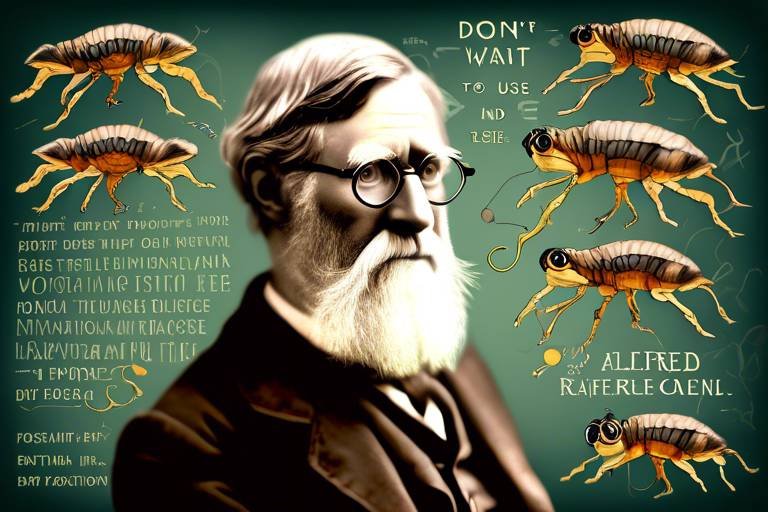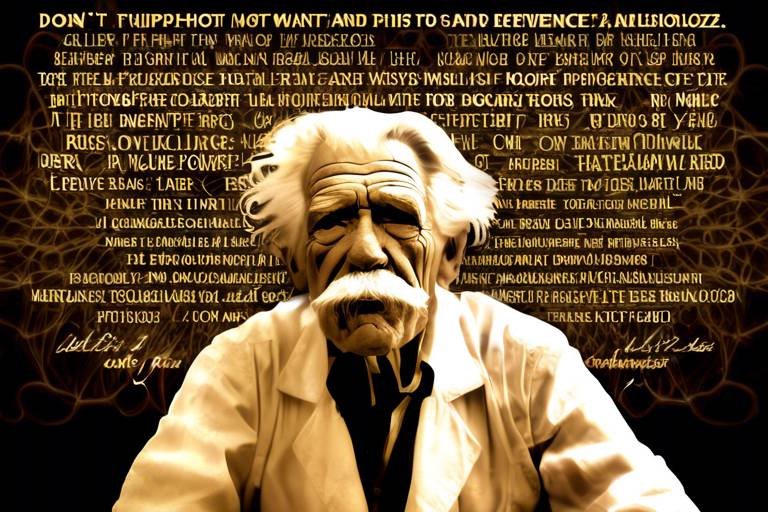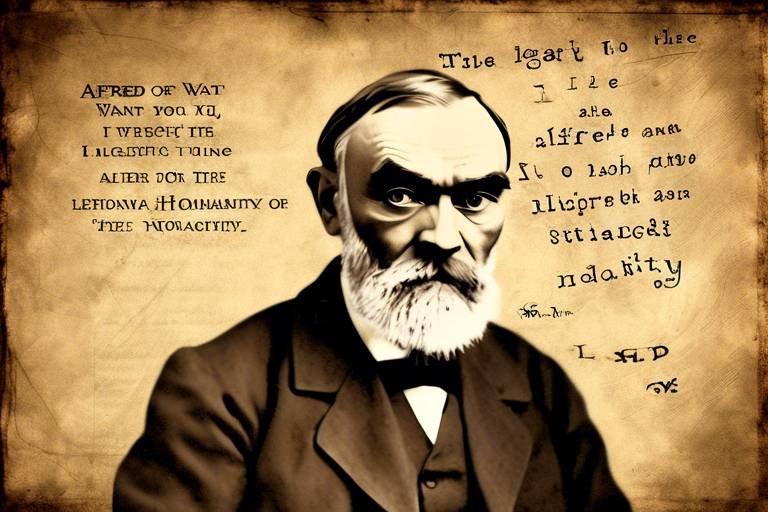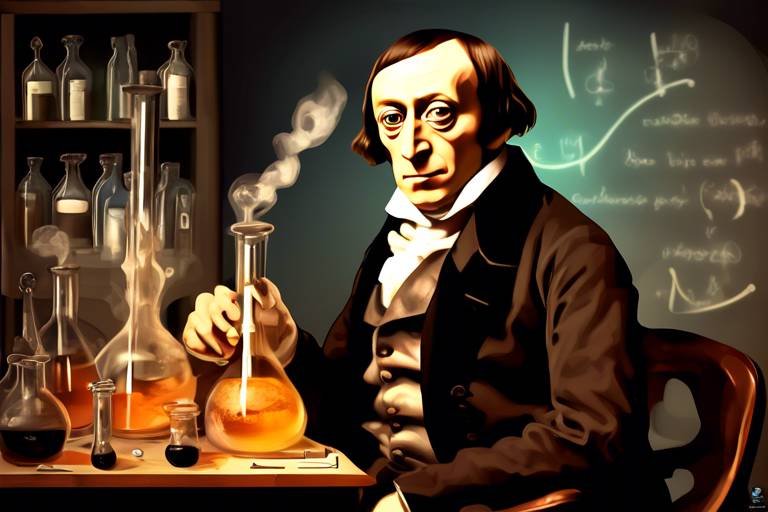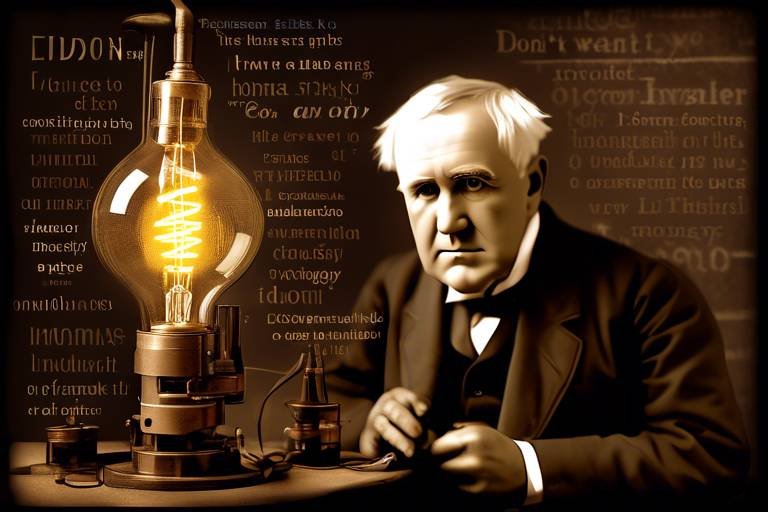The Life of Alfred Russel Wallace and Natural Selection
Alfred Russel Wallace was not just a name in the annals of science; he was a pioneer, a man whose adventurous spirit and insatiable curiosity about the natural world led him to co-discover one of the most profound concepts in biology: natural selection. Born on January 8, 1823, in Wales, Wallace's journey from a humble upbringing to becoming a renowned naturalist is a tale filled with surprises and explosions of discovery that shaped the very foundations of evolutionary theory.
Throughout his life, Wallace embarked on numerous expeditions that took him to some of the most remote and biodiverse regions of the world. His travels were not merely for the sake of adventure; they were driven by a deep desire to understand the intricate web of life on Earth. Wallace's contributions to science extend far beyond his collaboration with Charles Darwin; he delved into biogeography, ecology, and even the study of animal coloration, leaving a legacy that continues to influence modern biology.
This article explores the life and contributions of Alfred Russel Wallace, highlighting his scientific endeavors, personal experiences, and the lasting impact he had on evolutionary biology. From his early life and education to his groundbreaking explorations in the Amazon and the Malay Archipelago, we will uncover the remarkable journey of a man who dared to challenge the norms of his time and changed the way we understand the natural world.
Alfred Russel Wallace's formative years were marked by a profound curiosity about the natural world. Growing up in a family that valued education, he was exposed to various subjects, but it was the study of nature that truly captivated him. His childhood was filled with explorations of the local countryside, where he collected specimens and observed wildlife, laying the groundwork for his future scientific endeavors.
Despite facing financial hardships, Wallace was determined to pursue his education. He attended the local school and later became an apprentice to a surveyor, which provided him with invaluable skills in observation and detail. These early influences ignited a passion for natural history, leading him to read extensively about the works of prominent scientists of his time. It was during this period that he developed a keen interest in the theories of evolution, which would later shape his own groundbreaking ideas.
Wallace's extensive travels in the Amazon and the Malay Archipelago were pivotal in developing his theories on biodiversity and natural selection. His adventures were not just journeys; they were quests for knowledge that would challenge and expand the scientific understanding of his era. Each expedition brought new discoveries, insights, and challenges that tested his resolve and determination as a naturalist.
During his time in the Amazon, Wallace collected thousands of specimens, each one a piece of the puzzle in understanding the complex tapestry of life. He faced numerous challenges, including harsh weather, treacherous terrain, and the ever-present threat of disease. Yet, these obstacles only fueled his scientific ambitions. Wallace's findings during this expedition were groundbreaking, as he documented species that had never been seen before and began to formulate his ideas on species distribution.
The Amazon expedition profoundly affected Wallace's understanding of species distribution and evolution. He observed how geographical barriers influenced the variety of species in different regions, leading him to question the prevailing notions of his time. This experience laid the groundwork for his later work on natural selection, as he began to see the intricate connections between environment and biodiversity.
Wallace encountered numerous obstacles during his expeditions, from debilitating illnesses to financial difficulties. These challenges shaped his resilience and determination. Instead of being deterred, he embraced each setback as an opportunity to learn and adapt. His perseverance in the face of adversity is a testament to his character and passion for discovery.
Wallace's journey through the Malay Archipelago was a turning point in his scientific career. Here, he made critical observations about species variation and adaptation that would later influence his theories on natural selection. The rich biodiversity he encountered was both inspiring and perplexing, prompting him to delve deeper into the mechanisms of evolution.
Wallace's relationship with Charles Darwin was crucial for the theory of natural selection. Their correspondence and mutual respect for each other's work fostered a collaborative spirit that ultimately led to the joint presentation of their findings to the scientific community. This partnership highlighted the importance of collaboration in scientific discovery and the sharing of ideas.
Beyond natural selection, Wallace made significant contributions in various fields, including biogeography and ecology. His work on warning coloration in animals provided insights into survival strategies and predator-prey interactions. Wallace's ability to synthesize his observations into coherent theories demonstrates his profound understanding of the natural world.
Alfred Russel Wallace's impact on biology continues to resonate today. His groundbreaking ideas laid the foundation for modern evolutionary studies and inspired generations of scientists. Throughout his lifetime, he received numerous honors and recognition for his contributions, yet he remained humble, always attributing his discoveries to the wonders of nature.
Alfred Russel Wallace's life and work have left an indelible mark on science. His contributions to the understanding of natural selection, species distribution, and biodiversity continue to be relevant in contemporary evolutionary studies. As we reflect on his legacy, we are reminded of the importance of curiosity, exploration, and the relentless pursuit of knowledge in unraveling the mysteries of the natural world.
- Who was Alfred Russel Wallace? Wallace was a naturalist and co-discoverer of the theory of natural selection alongside Charles Darwin.
- What did Wallace contribute to science? He made significant contributions in natural selection, biogeography, and ecology.
- How did Wallace's expeditions influence his theories? His travels provided critical insights into species distribution and biodiversity, shaping his ideas on evolution.
- What is Wallace's legacy? Wallace's work continues to influence modern biology, and he is recognized as a key figure in the development of evolutionary theory.

Early Life and Education
Alfred Russel Wallace was born on January 8, 1823, in the small town of Usk, Wales. His early years were marked by a profound curiosity about the natural world that would later define his life's work. Growing up in a modest family, Wallace was the second of five children. His father, a carpenter, had limited means, which meant that formal education was a luxury. However, Wallace's thirst for knowledge was insatiable, and he often explored the lush countryside around his home, collecting specimens of plants and insects.
Wallace's formal education began at a local school, where he demonstrated an aptitude for science and a particular fascination with natural history. Despite the challenges of limited resources, he was encouraged by his teachers to pursue his interests. This early exposure to the wonders of nature laid the foundation for his future endeavors as a naturalist. He would often spend hours in the fields and woods, observing wildlife and collecting specimens, which ignited a passion that would last a lifetime.
At the age of 14, Wallace was forced to leave school to help support his family after his father's financial difficulties. He took up an apprenticeship as a surveyor, which, while not directly related to his interests, provided him with valuable skills in observation and documentation. During this time, he continued to educate himself by reading extensively about natural history and evolution. He was particularly influenced by the works of Charles Lyell and Georges Cuvier, which sparked his interest in geology and paleontology.
Wallace's early experiences were instrumental in shaping his scientific outlook. He was not just a passive observer; he was an active participant in the natural world around him. His childhood explorations and self-directed studies cultivated a keen sense of inquiry that would later drive his groundbreaking research. As he matured, Wallace's desire to explore the world grew stronger, leading him to seek opportunities beyond the confines of his home in Wales.
In 1848, at the age of 25, Wallace embarked on his first major expedition to the Amazon rainforest with his friend Henry Walter Bates. This journey would prove to be a turning point in his life, as it marked the beginning of his career as a naturalist and explorer. The Amazon expedition was not only a quest for knowledge but also a test of his resilience and determination. The challenges he faced during this trip would ultimately shape his understanding of biodiversity and evolution.
Wallace's early life and education were characterized by a blend of curiosity, perseverance, and a relentless pursuit of knowledge. These qualities would serve him well in his later explorations and scientific endeavors, making him one of the most significant figures in the history of evolutionary biology.
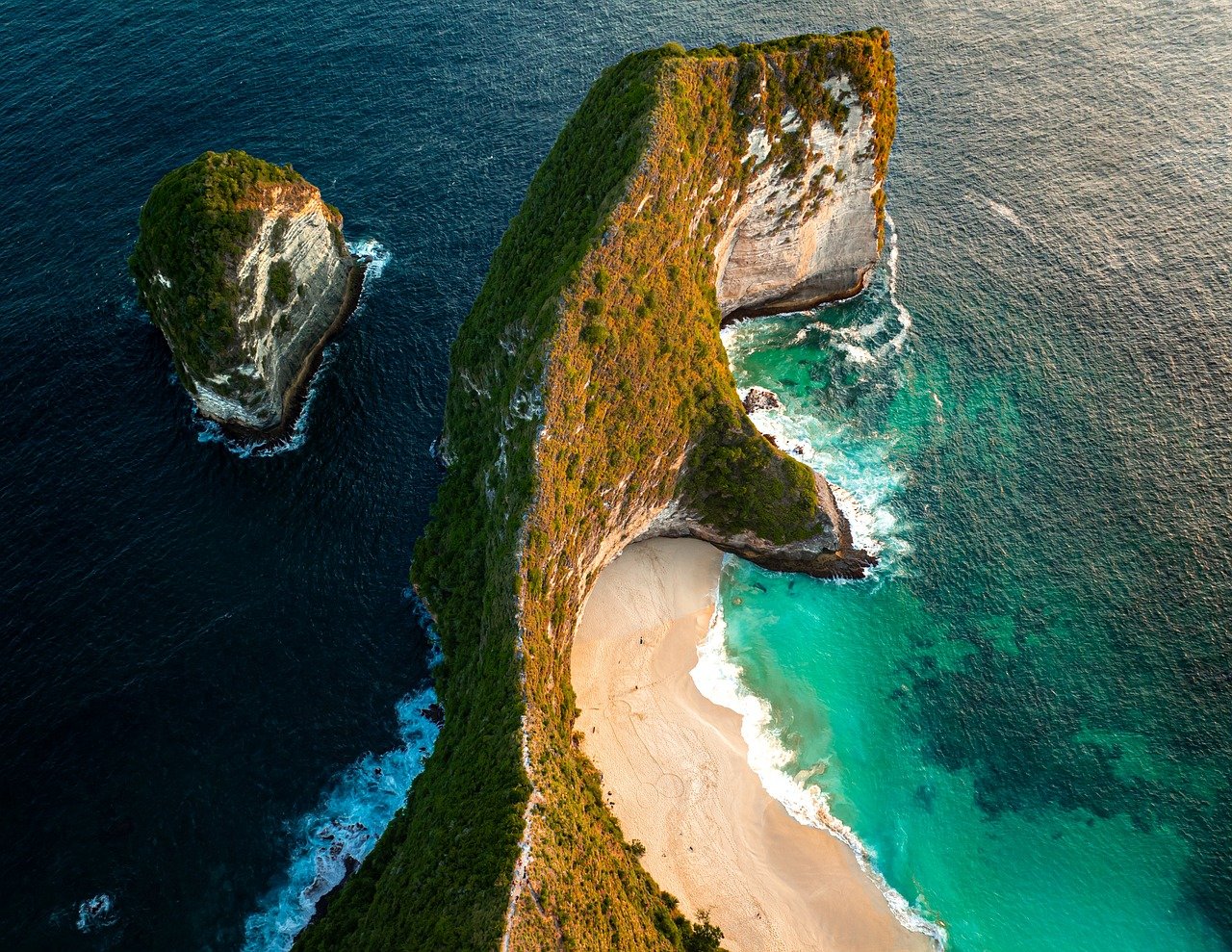
Exploration and Fieldwork
Alfred Russel Wallace's thirst for discovery led him on extraordinary journeys that not only shaped his understanding of the natural world but also contributed significantly to the field of evolutionary biology. His expeditions, particularly in the Amazon and the Malay Archipelago, were marked by a relentless pursuit of knowledge and a passion for uncovering the mysteries of biodiversity. Imagine setting off into the wild, surrounded by uncharted territories, where every rustle in the bushes could reveal a new species or a groundbreaking insight into the workings of nature. That's exactly what Wallace experienced during his adventurous life.
Wallace's journey began in the lush, vibrant landscapes of the Amazon rainforest. This was no ordinary trip; it was a quest filled with both excitement and peril. For four years, from 1848 to 1852, he trekked through dense jungles, navigated treacherous rivers, and faced the relentless challenges posed by the environment. The Amazon was a treasure trove of biodiversity, and Wallace was determined to collect as many specimens as possible. He meticulously documented his findings, sending back thousands of specimens to England. This was a time when natural history was all the rage, and Wallace was right in the thick of it, contributing to the growing body of knowledge about the natural world.
During his time in the Amazon, Wallace collected numerous specimens, which fueled his scientific ambitions. The sheer diversity of life he encountered was staggering—he described everything from exotic birds to peculiar insects, many of which were previously unknown to science. Each specimen was a piece of a larger puzzle, and Wallace was determined to fit them all together. His observations during this expedition were pivotal, as he began to formulate ideas about species distribution and adaptation. However, it wasn't all smooth sailing; Wallace faced numerous challenges that tested his resolve.
The Amazon expedition profoundly affected Wallace's understanding of species distribution and evolution. One of the most significant realizations he had was how geographical barriers influenced the distribution of species. He noted that animals and plants were not randomly scattered but rather grouped in ways that suggested a deeper connection to their environments. This insight would later play a crucial role in his formulation of the theory of natural selection. The experience of collecting specimens and observing their behaviors in their natural habitats gave him a unique perspective that few of his contemporaries possessed.
While the thrill of discovery drove him forward, Wallace encountered numerous obstacles that would have deterred a lesser adventurer. Disease, financial difficulties, and the harsh realities of life in the jungle were constant companions. Imagine battling fever and fatigue while trying to document the wonders of the natural world around you. Yet, these challenges only strengthened Wallace's resilience and determination as a naturalist. He learned to adapt, often relying on the kindness of local communities and his own ingenuity to survive. This tenacity not only shaped his character but also enriched his scientific endeavors.
After his transformative experience in the Amazon, Wallace set his sights on the Malay Archipelago, a region that would prove to be pivotal in the development of his ideas on natural selection. Between 1854 and 1862, he traveled through islands such as Borneo, Sumatra, and Java, immersing himself in diverse ecosystems. The contrast between the species he encountered in the Amazon and those in the Malay Archipelago further fueled his curiosity. He observed how isolation led to unique adaptations, and how closely related species could be found in proximity yet exhibit significant differences. This journey solidified his theories and laid the groundwork for his later work.
Wallace's exploration and fieldwork were not just about collecting specimens; they were about understanding the intricate web of life that connects all organisms. His adventures remind us that science often requires a spirit of exploration and an openness to the unknown. In a world where the mysteries of nature are still being unraveled, Wallace's legacy as a pioneer of natural history continues to inspire future generations of scientists.
- What motivated Alfred Russel Wallace to explore the Amazon and the Malay Archipelago?
Wallace was driven by a deep curiosity about the natural world and a desire to understand the mechanisms of evolution and species distribution. - How did Wallace's expeditions contribute to the theory of natural selection?
His observations of species in different geographical locations helped him develop ideas about adaptation and the influence of the environment on species evolution. - What challenges did Wallace face during his explorations?
Wallace encountered diseases, financial difficulties, and the harsh realities of life in the jungle, which tested his resilience and determination. - What legacy did Wallace leave behind?
Wallace's work laid the foundation for modern evolutionary biology, and his contributions continue to influence scientific thought today.

Amazon Expedition
Alfred Russel Wallace's was not just a journey; it was an adventure that would shape the very foundation of modern evolutionary biology. In the mid-19th century, Wallace set sail for the Amazon Basin, armed with nothing but a deep curiosity and a determination to uncover the secrets of the natural world. This expedition was a turning point in his life, filled with excitement and peril as he navigated the lush, uncharted territories of South America.
During his time in the Amazon, Wallace meticulously collected a staggering array of specimens—over 125,000 in total! His haul included everything from exotic insects to rare birds, each specimen serving as a piece of the puzzle he was trying to solve regarding the diversity of life. The sheer volume of his collection is a testament to his dedication. Imagine spending countless hours in the humid jungles, battling mosquitoes, and carefully documenting each find. Wallace’s passion for natural history was palpable, and it drove him to work tirelessly in the field.
However, the Amazon Expedition was not without its challenges. Wallace faced numerous obstacles that tested his resolve. The dense jungles were fraught with dangers, including treacherous terrain, unpredictable weather, and, most daunting of all, diseases that were foreign to him. He battled bouts of fever that left him weak and vulnerable, but his love for discovery pushed him forward. It was during these trying times that Wallace's resilience truly shone.
One of the most significant outcomes of this expedition was Wallace's realization about the distribution of species. He began to notice patterns in the biodiversity around him, leading him to question how and why certain species were found in specific regions while others were not. This line of inquiry would eventually lead to his groundbreaking ideas about natural selection and the evolution of species. The Amazon was like a grand stage where the drama of life unfolded before his eyes, and Wallace was determined to document every act.
Wallace’s experiences in the Amazon also forced him to confront the harsh realities of scientific exploration. He faced financial difficulties that often left him on the brink of despair. At one point, he even had to sell some of his specimens to fund his ongoing research. Yet, these struggles only fueled his determination to succeed. Every setback became a stepping stone, and every challenge turned into an opportunity for growth.
In summary, the Amazon Expedition was not just an adventure; it was a transformative experience for Wallace. It was here that he began to formulate the ideas that would later coalesce into the theory of natural selection. His time in the Amazon taught him invaluable lessons about the interconnectedness of life and the intricate web of ecosystems. This expedition was the spark that ignited his lifelong journey into the world of natural history, and it laid the groundwork for his future collaborations, particularly with Charles Darwin.
- What motivated Wallace to explore the Amazon?
Wallace was driven by an insatiable curiosity about the natural world and a desire to understand the diversity of life. - How did Wallace's findings in the Amazon contribute to his theory of natural selection?
His observations of species distribution and biodiversity during the expedition were pivotal in shaping his ideas about evolution. - What challenges did Wallace face during his expedition?
He encountered numerous obstacles, including disease, financial difficulties, and the harsh realities of jungle exploration.

Impact of the Amazon Trip
Alfred Russel Wallace's expedition to the Amazon was nothing short of transformative, both for him personally and for the field of natural history. Imagine setting sail into the vast, uncharted territories of the Amazon rainforest, a place teeming with life yet shrouded in mystery. Wallace returned with a treasure trove of specimens and observations that would forever change the way we understand biodiversity and species distribution.
During his time in the Amazon, Wallace meticulously collected over 125,000 specimens, which included a diverse array of insects, birds, and mammals. This monumental effort not only fueled his scientific ambitions but also laid the groundwork for his later theories on natural selection. One cannot help but marvel at the sheer determination it took for Wallace to navigate the dense jungles and unpredictable rivers, often facing perilous conditions. The challenges he encountered, from tropical diseases to financial constraints, honed his resilience and deepened his commitment to the study of nature.
The significance of Wallace's findings during this expedition is profound. His observations led him to recognize patterns in species distribution that hinted at the mechanisms of evolution. For instance, he noted that similar species could be found in different geographical locations, separated by barriers such as rivers or mountains. This sparked his curiosity about how species adapted to their environments over time. The implications of these discoveries were monumental, as they provided crucial insights into the processes that drive evolution.
Furthermore, Wallace's Amazon trip also influenced his views on the interconnectedness of life. He began to see the natural world not as a collection of isolated entities but as a complex web of relationships. This holistic perspective would later inform his ideas on natural selection and biogeography. In many ways, the Amazon was not just a place of exploration for Wallace; it was a catalyst for his intellectual evolution.
In summary, the impact of Wallace’s Amazon expedition was multifaceted. It not only enriched the scientific community with invaluable specimens but also shaped his understanding of evolution in ways that would resonate through the ages. His experiences in the Amazon served as a foundation for his later work, establishing him as a pivotal figure in the history of evolutionary biology.
- What was the main purpose of Wallace's Amazon expedition?
The primary goal was to collect specimens and observe biodiversity to understand species distribution and evolution better. - How did Wallace's findings influence the theory of natural selection?
His observations of species distribution and adaptation provided critical insights that complemented Darwin's theories on natural selection. - What challenges did Wallace face during his expedition?
Wallace encountered numerous obstacles, including tropical diseases, financial difficulties, and the harsh conditions of the Amazon rainforest. - Why is Wallace considered a co-discoverer of natural selection?
Wallace independently formulated a theory of natural selection that paralleled Darwin's, leading to their joint presentation of their ideas to the scientific community.

Challenges in the Field
Alfred Russel Wallace's journeys into the depths of the Amazon and the Malay Archipelago were not merely adventures; they were epic quests fraught with challenges that tested his resolve and passion for natural history. Imagine setting sail for uncharted territories, armed with nothing but a notebook, a few tools, and an insatiable curiosity. That was Wallace's reality. The lush, vibrant jungles he traversed were as treacherous as they were beautiful.
One of the most daunting challenges Wallace faced was the relentless onslaught of tropical diseases. The Amazon, often dubbed the "lungs of the Earth," is a paradise for biodiversity but a nightmare for the unprepared traveler. Wallace battled fevers, infections, and the ever-looming threat of malaria. Each day was a test of endurance as he pushed through illness, driven by his desire to understand the natural world around him. His resilience in the face of such adversity is a testament to his character and dedication.
Furthermore, financial difficulties loomed large over Wallace's expeditions. Securing funding for his travels was no easy feat. He often relied on his own savings, which dwindled faster than he could collect specimens. Imagine the frustration of gathering incredible data and yet worrying about how to afford the next leg of your journey. This financial strain forced Wallace to become resourceful; he often had to barter or sell specimens to continue his work. It was a brutal balancing act between passion and practicality.
Despite these hurdles, Wallace's spirit was unyielding. He embraced the unpredictability of his environment, adapting to the challenges as they arose. For instance, he learned to navigate the intricate waterways of the Amazon, using local knowledge and his own intuition to find the best routes for exploration. His adaptability and quick thinking not only helped him survive but also enhanced his understanding of the ecosystems he studied.
Wallace's experiences in the field were not just about collecting specimens; they were about unraveling the mysteries of life itself. Each challenge he faced contributed to his growing understanding of species distribution and evolution. The trials he endured were not mere obstacles but stepping stones that shaped his theories and insights. In many ways, these challenges were as crucial to his scientific journey as the discoveries he made.
In summary, the challenges faced by Alfred Russel Wallace in the field were numerous and formidable. From battling diseases to overcoming financial hurdles, these experiences forged a resilient naturalist who would go on to change the course of evolutionary biology. His story is a reminder that true passion often requires perseverance in the face of adversity.
- What were some of the diseases Wallace faced during his expeditions?
Wallace encountered various tropical diseases, including malaria and yellow fever, which were prevalent in the regions he explored. - How did Wallace fund his travels?
Wallace often used his savings and sold specimens to fund his expeditions, facing financial challenges throughout his journey. - What impact did Wallace's challenges have on his scientific work?
The challenges he faced enhanced his resilience and adaptability, ultimately enriching his understanding of biodiversity and evolution.

Malay Archipelago Journey
Alfred Russel Wallace's journey through the Malay Archipelago was nothing short of extraordinary. This expedition, which spanned several years in the mid-19th century, was a pivotal chapter in his life and significantly influenced his theories on natural selection. Imagine a world filled with lush rainforests, vibrant wildlife, and exotic islands; this was the backdrop against which Wallace made groundbreaking observations that would challenge the very fabric of scientific thought.
Wallace set sail for the Malay Archipelago in 1854, driven by an insatiable curiosity and a desire to explore the rich biodiversity of the region. He meticulously collected specimens, documenting everything from birds and insects to plants and fossils. His keen eye for detail allowed him to notice patterns in species distribution that others had overlooked. He famously said that the archipelago was a "natural laboratory," where he could observe evolution in action. The sheer diversity of species he encountered fueled his passion for understanding how life adapts and evolves in different environments.
One of the most significant aspects of Wallace's journey was his realization of the Wallace Line, an imaginary boundary that separates the ecozones of Asia and Australia. This line illustrated the stark differences in species on either side, showcasing how geographical barriers can influence evolutionary paths. Wallace's observations led him to conclude that species are not static; rather, they evolve over time in response to their environments. This insight was revolutionary and laid the groundwork for his later theories on natural selection.
Throughout his travels, Wallace faced numerous challenges that tested his resolve. From navigating treacherous waters to dealing with tropical diseases, each obstacle only strengthened his determination. He often found himself in precarious situations, such as when he contracted malaria, which left him bedridden for weeks. Yet, despite these hardships, Wallace's passion for discovery remained unshaken. His resilience is a testament to his dedication as a naturalist and explorer.
The Malay Archipelago journey was not just about collecting specimens; it was also about forging connections with local communities. Wallace interacted with indigenous peoples, learning from their knowledge of the land and its creatures. These exchanges enriched his understanding of the natural world and highlighted the importance of cultural perspectives in scientific inquiry.
In summary, Wallace's expedition through the Malay Archipelago was a transformative experience that shaped his scientific outlook. The insights he gained during this journey were instrumental in developing his ideas about evolution and natural selection. Wallace returned from the archipelago not only with a treasure trove of specimens but also with a deeper understanding of the complexities of life on Earth. His work in this region would ultimately contribute to a paradigm shift in biology, influencing generations of scientists to come.
- What was the Wallace Line?
The Wallace Line is a boundary that separates the ecozones of Asia and Australia, illustrating the significant differences in species found on either side.
- What were some challenges Wallace faced during his journey?
Wallace encountered numerous challenges, including tropical diseases, difficult navigation, and financial hardships, all of which tested his resilience.
- How did Wallace's journey influence his theories?
His observations of species distribution and adaptation during his travels were crucial in forming his theories on natural selection and evolution.

Collaboration with Charles Darwin
Alfred Russel Wallace's relationship with Charles Darwin was not just a partnership; it was a collaboration that would change the course of scientific history. Imagine two brilliant minds, both captivated by the mysteries of life, working separately yet simultaneously to unravel the same enigma—how species evolve. This synergy led to the formulation of the theory of natural selection, a concept that would forever alter our understanding of biology.
Wallace and Darwin's correspondence began in the early 1850s, fueled by their mutual interest in evolutionary theory. Wallace, who was conducting his research in the Amazon and later in the Malay Archipelago, frequently shared his findings with Darwin. This exchange of ideas was crucial, as it not only provided Wallace with insights from Darwin's extensive work but also allowed Darwin to see the practical implications of his theories through Wallace's observations.
In 1858, Wallace sent Darwin a manuscript outlining his own ideas on natural selection, which he had developed after years of fieldwork. This was a pivotal moment in their collaboration. Both men were astonished to discover that they had arrived at remarkably similar conclusions regarding the mechanisms of evolution. The significance of this moment cannot be overstated; it was as if two explorers had independently charted the same uncharted territory and were now ready to share their maps with the world.
To honor their joint contributions, a joint presentation of their work was arranged for the Linnean Society of London in July 1858. The event marked the first public introduction of the concept of natural selection. In this presentation, Wallace's paper was read alongside excerpts from Darwin’s unpublished writings. It was a moment filled with both excitement and tension, as the scientific community began to grasp the implications of their findings. The table below summarizes the key aspects of their collaboration:
| Aspect | Darwin's Contributions | Wallace's Contributions |
|---|---|---|
| Initial Ideas | Developed the concept of natural selection over years of research. | Independently arrived at similar conclusions through fieldwork. |
| Key Discoveries | Focused on domestic species and artificial selection. | Investigated species distribution and biodiversity in the tropics. |
| Public Presentation | Presented at the Linnean Society in 1858. | Co-presented his findings, establishing a collaborative spirit. |
This collaboration was not without its challenges. Wallace, who was often in the field, relied on Darwin's extensive knowledge and support. Conversely, Darwin faced the pressure of being the first to publish his findings, which he had hesitated to do for fear of the backlash from the scientific community. Their relationship exemplified the idea that science is not a solitary endeavor; it thrives on collaboration, discussion, and the sharing of ideas.
In the years that followed, both men would continue to develop their theories, but their collaboration laid the groundwork for modern evolutionary biology. Wallace’s emphasis on the importance of environmental factors and geographical distribution enriched Darwin’s framework, leading to a more comprehensive understanding of evolution. Their partnership reminds us that sometimes, the greatest discoveries come not from solitary thinkers, but from those who dare to share their visions with one another.
- What was the main contribution of Wallace and Darwin?
Both Wallace and Darwin independently developed the theory of natural selection, explaining how species evolve over time through the survival of the fittest. - How did their collaboration influence evolutionary biology?
Their collaboration brought together diverse observations and ideas, leading to a more robust understanding of evolution that continues to influence biology today. - Did Wallace receive equal recognition as Darwin?
While both made significant contributions, Darwin is often more recognized due to his earlier publications and the broader impact of his work.

Scientific Contributions
Alfred Russel Wallace was not just a co-discoverer of the theory of natural selection; his scientific contributions spanned a wide range of fields within biology. His keen observations and meticulous research laid foundational stones in various areas, including biogeography, ecology, and even the study of warning coloration in animals. Wallace's insights into the distribution of species were groundbreaking, leading him to propose ideas that would later evolve into the modern field of biogeography.
One of Wallace's most notable contributions was his formulation of the Wallace Line, an imaginary boundary that separates the ecozones of Asia and Australia. This line is significant because it highlights the distinct differences in species found on either side, showcasing how geographical barriers can influence evolutionary paths. The concept of the Wallace Line not only illustrated Wallace's understanding of species distribution but also underscored the importance of environmental factors in shaping biodiversity.
Wallace's explorations also led him to delve into the intricacies of ecology. He examined how different species interact with one another and their environments, emphasizing the delicate balance that sustains ecosystems. His work in this area was crucial in understanding the interdependence of species, which is a key principle in ecology today. Additionally, Wallace's research on warning coloration in animals, particularly in insects and reptiles, revealed how certain colors and patterns serve as a defense mechanism against predators. This concept opened up new avenues for understanding evolutionary adaptations and the survival strategies of various species.
Moreover, Wallace was an advocate for the idea that evolution was not solely driven by competition but also by cooperation among species. He believed that mutualism, where different species benefit from each other, played a significant role in the evolutionary process. This perspective was quite revolutionary at the time and is increasingly recognized in contemporary evolutionary biology.
In summary, Alfred Russel Wallace's scientific contributions were vast and varied. His work not only helped to establish the framework for the theory of natural selection but also enriched our understanding of biodiversity through his studies in biogeography and ecology. Wallace's legacy continues to inspire scientists and naturalists alike, as they explore the complexities of life on Earth.
- What is the Wallace Line?
The Wallace Line is an imaginary line that separates the ecozones of Asia and Australia, highlighting the distinct differences in species found on either side. - How did Wallace contribute to the theory of natural selection?
Wallace independently developed the concept of natural selection, which he presented alongside Charles Darwin's findings, leading to the establishment of this fundamental principle of evolution. - What is warning coloration?
Warning coloration refers to the bright colors and patterns found in certain animals that serve as a defense mechanism against predators, signaling that they may be toxic or unpalatable. - In what other fields did Wallace make contributions?
In addition to natural selection, Wallace made significant contributions to biogeography, ecology, and the study of species interactions.
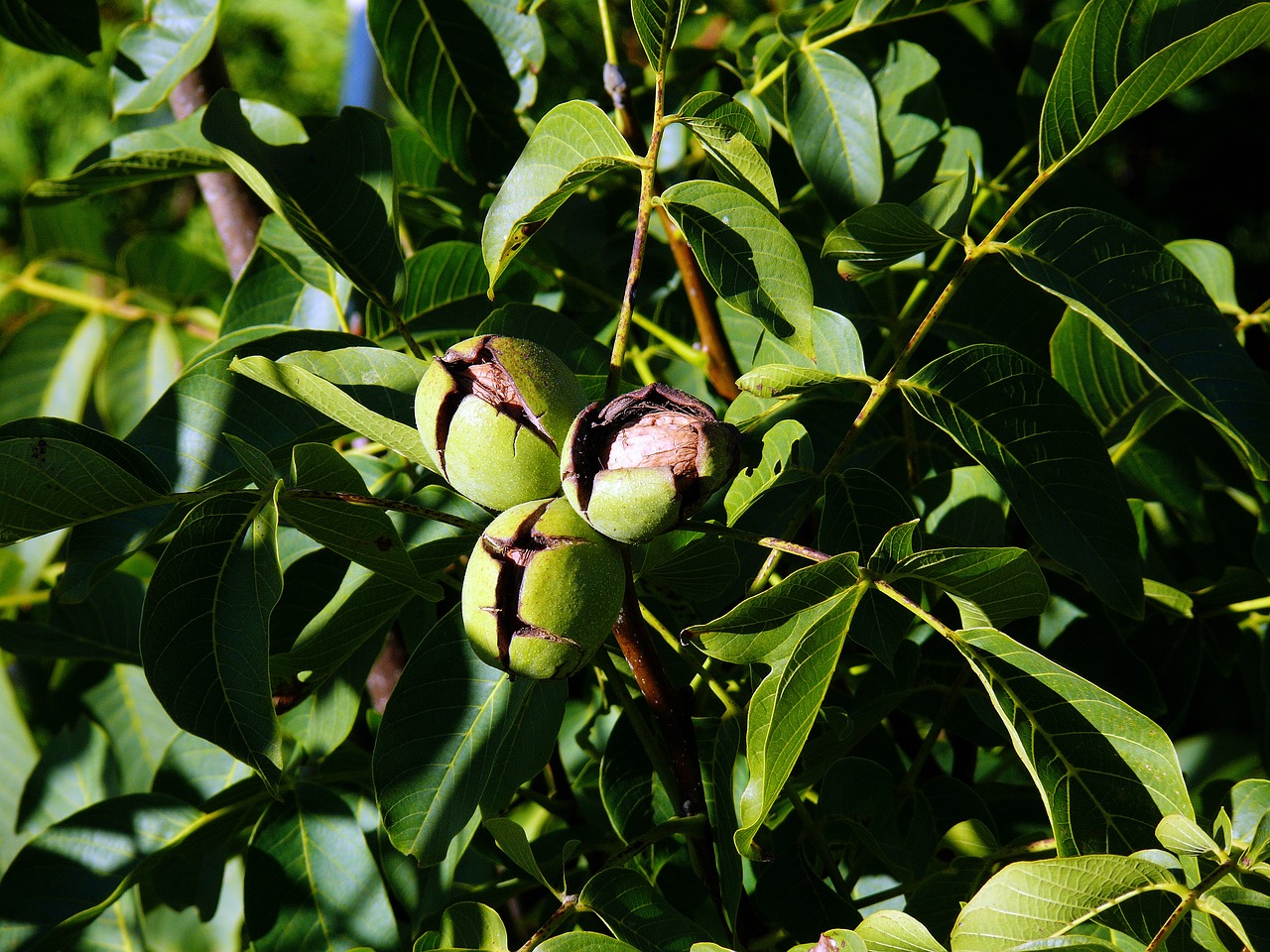
Legacy and Recognition
Alfred Russel Wallace's contributions to science extend far beyond his co-discovery of the theory of natural selection. His legacy is a rich tapestry woven from his extensive research, adventurous spirit, and profound insights into the natural world. While many may recognize Charles Darwin as the face of evolutionary biology, Wallace's role is equally significant, and his work continues to inspire scientists and naturalists alike.
Wallace's influence can be seen in various fields, including biogeography, where he laid the groundwork for understanding species distribution. His observations during his travels in the Amazon and the Malay Archipelago led to the formulation of the Wallace Line, a boundary that distinguishes the distinct fauna of Asia and Australia. This concept has become a fundamental principle in the study of biogeography, illustrating how geographical barriers influence the evolution of species.
Despite facing numerous challenges throughout his life, including financial hardships and health issues, Wallace's resilience set him apart as a pioneering figure in science. His ability to overcome obstacles is a testament to his passion for discovery and understanding. In recognition of his remarkable contributions, Wallace received numerous honors during his lifetime, including being elected a Fellow of the Royal Society in 1893, a prestigious accolade that acknowledged his significant impact on the scientific community.
After his passing in 1913, Wallace's legacy continued to flourish. He has been celebrated in various ways, including:
- Numerous memorials and statues erected in his honor.
- Institutions and awards named after him, such as the Wallace Medal, which recognizes outstanding contributions to the field of biology.
- His works remain a vital part of educational curricula, inspiring new generations of scientists.
Moreover, Wallace's ideas on biodiversity and conservation resonate strongly in today's discussions on environmental issues. His early warnings about the impact of human activities on nature are more relevant than ever, as scientists and activists strive to protect the planet's fragile ecosystems. In this sense, Wallace was not only a naturalist but also a visionary, advocating for the preservation of the natural world long before it became a global concern.
In summary, Alfred Russel Wallace's legacy is a testament to the power of curiosity, exploration, and perseverance. His recognition as a co-founder of the theory of natural selection is just the tip of the iceberg. The enduring impact of his work continues to shape our understanding of evolution, ecology, and conservation, ensuring that his contributions will be remembered and celebrated for generations to come.
- What is the Wallace Line? - The Wallace Line is a boundary that separates the unique species of the Asian continent from those of Australia, reflecting the impact of geography on evolution.
- Did Alfred Russel Wallace collaborate with Charles Darwin? - Yes, Wallace and Darwin corresponded extensively, and their collaboration was crucial in the development and acceptance of the theory of natural selection.
- What other fields did Wallace contribute to? - Besides natural selection, Wallace made significant contributions to biogeography, ecology, and the study of warning coloration in animals.

Conclusion: Wallace's Enduring Influence
Alfred Russel Wallace's contributions to science are nothing short of remarkable. His pioneering work on natural selection, which he co-discovered with Charles Darwin, has fundamentally shaped our understanding of evolution. Wallace's insights into biodiversity and species distribution have laid the groundwork for modern biology, making him a pivotal figure in the field. But his influence goes beyond just the theory of evolution; it extends into various domains of science, such as biogeography and ecology.
One of the most fascinating aspects of Wallace's legacy is how he approached science. He was not just a collector of specimens but a deep thinker who sought to understand the underlying principles of nature. His travels through the Amazon and the Malay Archipelago were filled with challenges, yet these experiences enriched his perspective and fueled his scientific ambitions. Wallace's ability to observe and interpret the natural world was extraordinary, allowing him to make connections that others might have missed.
Today, Wallace's legacy is celebrated in various ways. Numerous institutions and awards bear his name, honoring his contributions to science. For instance, the Wallace Medal is awarded to individuals who have made significant contributions to the understanding of evolution and natural history. Additionally, many educational programs and research initiatives continue to draw inspiration from his work, ensuring that his ideas remain relevant in contemporary discussions about biodiversity and conservation.
Moreover, Wallace's thoughts on the interconnectedness of life resonate with modern ecological principles. He recognized that all species are part of a complex web of interactions, a concept that is central to current environmental science. As we face challenges like climate change and habitat loss, Wallace's insights remind us of the importance of preserving biodiversity and understanding the delicate balance of ecosystems.
In conclusion, Alfred Russel Wallace's influence is enduring and multifaceted. His contributions to science not only revolutionized our understanding of evolution but also paved the way for future generations of scientists. As we continue to explore the mysteries of the natural world, we owe a debt of gratitude to Wallace for his pioneering spirit and unwavering dedication to uncovering the truths of life on Earth.
- Who was Alfred Russel Wallace?
Alfred Russel Wallace was a British naturalist, explorer, and biologist who is best known for independently formulating the theory of natural selection alongside Charles Darwin. - What were Wallace's main contributions to science?
Wallace's main contributions include the theory of natural selection, biogeography, and studies on warning coloration in animals. - How did Wallace's expeditions influence his work?
His travels in the Amazon and the Malay Archipelago provided him with critical insights into species distribution and biodiversity, which were foundational to his scientific theories. - What is Wallace's legacy today?
Wallace's legacy is honored through various awards, institutions, and ongoing research that continues to draw from his ideas on evolution and ecology.
Frequently Asked Questions
- Who was Alfred Russel Wallace?
Alfred Russel Wallace was a British naturalist, explorer, and biologist, best known for independently formulating the theory of natural selection alongside Charles Darwin. His extensive research and travels significantly contributed to the field of evolutionary biology.
- What were Wallace's major contributions to science?
Wallace made several key contributions, including the concept of natural selection, advancements in biogeography, and insights into the ecology of species. He also researched warning coloration in animals and the distribution of species across different regions.
- How did Wallace's early life influence his scientific pursuits?
Wallace's early life, marked by curiosity and a love for nature, played a crucial role in shaping his scientific interests. His education and formative experiences sparked a lifelong passion for exploring the natural world, ultimately leading him to become a prominent figure in evolutionary studies.
- What challenges did Wallace face during his expeditions?
During his expeditions, particularly in the Amazon and the Malay Archipelago, Wallace faced numerous challenges, including harsh environmental conditions, diseases, and financial difficulties. These obstacles tested his resilience and determination, further fueling his passion for natural history.
- How did Wallace's collaboration with Darwin impact his work?
Wallace's collaboration with Darwin was pivotal in the development of the theory of natural selection. Their correspondence and mutual respect led to the joint presentation of their findings, which helped solidify the foundation of evolutionary biology as we know it today.
- What is Wallace's legacy in modern science?
Wallace's legacy endures in the field of biology, where his contributions to evolutionary theory, biogeography, and ecology continue to influence contemporary research. He is often celebrated as a co-founder of evolutionary theory, alongside Darwin, and his work remains relevant in discussions about biodiversity and conservation.

